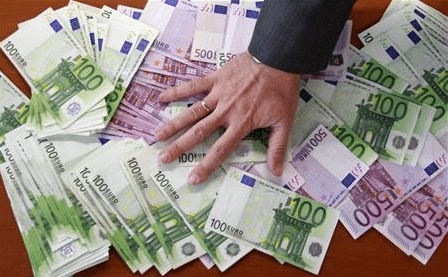“First, there is liquidity — this major catalyst for equities since last October looks set to subside with the Fed seemingly backing off from a QE expansion, at least over the near-term. And the ECB is back talking about inflation so it doesn’t even look like a rate cut is coming despite escalating recession pressures in Europe. It is now also highly doubtful that China will re-open the monetary taps following the disappointing March inflation data. The liquid lunch looks less likely.
Second, there is the U.S. economy — not just the disappointing jobs data on Friday but the reality that 70% of the releases in the past month have come in below expectations. While the chain stores did report what seemed on the surface to be a solid +3.9% YoY sales gain in March, keep in mind that yet again we had very mild weather and we also had an early Easter effect.
Third, there is the rapid slowing in corporate earnings. In Q4, we had the YoY trend in S&P 500 operating earnings slip into single-digits (+9.2%) for the first time in two years, and absent Apple, the pace would have been 6.2% (see the front page of the Investor’s Business Daily). Only 62% of companies beat their estimates, which is far below average. As for Q1, the consensus is all the way down to +3.2% on a YoY basis — well off the +5.5% expectation at the turn of the year and the +12.8% forecast in the mid-part of 2011. Strip Apple out of the numbers, and you are talking about earnings growth of practically nothing— +1.8%.
Not only has earnings growth basically evaporated, but the ratio of negative to positive guidance has risen to levels we last saw two years ago, margins are poised to shrink to a two-year low as well, and only three S&P 500 sectors are actually seen raising their earnings from year-ago levels. Now the question is whether or not the market can move up with earnings contracting and the answer is — of course! We have seen that in the past, as rare as it may be. Just go back to 1998, when the Asian meltdown and strong U.S. dollar severely pinched U.S. corporate earnings, yet the S&P 500 rallied more than 20% that year. But what else happened? Well, we had the Fed cut rates three times as a super-strong antidote, and did so at a time when there was no evident slack in the labor market. Plus, we were in the early stages of an internet-led productivity spree, which underpinned profit margins. In addition, we had a Democratic president working with Congress to pass legislation that reduced red tape, labour rigidities and taxation — with no budget deficit! Please, tell me if we currently have these as antidotes for a weakening trend in corporate profits.
Fourth, there is Europe making the headlines again, and not in a positive way. Spain is back on the radar screen with a very bad bond auction last week serving up as a referendum on the government’s fiscal plan — sending the 10– year yield back up close to 6%.
We have the two rounds of French elections looming (April 22nd and May 6th) and the new government is going to have precious little time or margin of error with regard to delivering a fiscal package that will pass the ‘sniff test’ for Mr. Market. It is very clear that, in Italy, Mario Monti’s honeymoon period is over as he vacillates over parts of his economic reform package. Financial stress is highlighted by the poor performance of the euro area banks (the group that got the cyclical bounce going last November) as the group sagged 4.3% last week and is now trading near three-month lows.
On the macro front, Germany had been an economic lynchpin but no longer with industrial production sliding 1.3% in February and a downward revision to January. U.K. factory output also fell 1% — a big shock to a consensus looking for a 0.1% gain. Not just Europe, but the global economy in general is cooling off. The HSBC diffusion survey of China’s service sector slipped to 53.3 in March from 53.9 in February. Russia’s economy ministry just shaved its 2012 growth forecast to 3.4% from 3.7%.
Fifth, there is the poor technical picture. The large number of distribution days of late. The number of stocks making fresh 52-week highs is on the decline. At last week’s highs in the major averages, divergences were popping up everywhere. One particular glaring anomaly was the surge in global equities in Q1 and the sharp rise in government bond yields at a time when the CRB index faltered — if the first two asset classes were actually prescient in the view of global reflation, wouldn’t it have shown up in basic material prices given their inherent cyclical sensitivities?
Sixth, valuation support is less of a positive than it was six months ago. The cyclically-adjusted P/E at 22x for the S&P 500 is nearly 40% higher than the long-run average of 16x. The forward P/E ratio at over 13x now is about in line with the historical norm. Some nifty analysis cited on page B6 of the weekend WSJ (Why Stocks Look Too Pricey) found that when real rates are negative, as they are today, they tend to represent periods of economic turmoil and as such, the typical P/E multiple during these times is 11x — versus today’s trailing multiple of 14x. On this basis, the market as a whole (keeping in mind that we don’t buy the market, just the slices of it that we strongly believe are undervalued) is overpriced by more than 20%.”
Source: Gluskin Sheff
PS: Je te recommande de lire ceci :
Note: Tous les investissements sont partagés en temps réel sur L'Académie des Graphs. Le portefeuille représente mes convictions personnelles consolidées (de mes différents courtiers) et n'est pas une incitation à l'achat ni à la vente. La performance en cours inclus les gains ou moins values latentes et l'impact du change sur les actions étrangères. Performance 2024: +41%; 2023: +38%; 2022: +46%; 2021: +122%; 2020: +121%; 2019: +79%; 2018: +21%; 2017: +24%; 2016: +12%; 2015: +45%; 2014: +30%; 2013:+72%, 2012:+9%, 2011:-11%... Clique-ici pour découvrir le logiciel d'aide à la décison que j'utilise au quotidien pour détecter au bon moment les meilleures actions.



